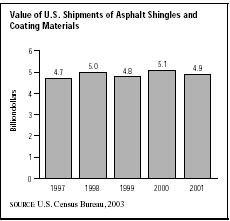SIC 2952
ASPHALT FELTS AND COATINGS
This category is comprised of establishments that manufacture asphalt in roll or shingle form—either smooth or faced with grit—and roof cements or coatings. Examples of products include asphalt brick siding, tar coating compounds, roofing fabrics, pitch, shingles, and tarpaper. Manufacturers of asphalt paving mixtures and blocks are described in SIC 2951: Asphalt Paving Mixtures.
NAICS Code(s)
324122 (Asphalt Shingle and Coating Materials Manufacturing)
Asphalt is a compound made of hydrogen and carbon, with minor proportions of nitrogen, sulfur, and oxygen. It exists in forms ranging from a black liquid to a glassy solid. Most asphalt is obtained as a byproduct of the distillation of petroleum or other natural materials. Some natural asphalt, however, is extracted from organic mineral deposits in the early stages of their breakdown into petroleum.
When formed into felts and coatings, asphalt provides a reliable protectant and sealant. It is extremely water-repellent, tolerates temperature fluctuations, and resists the breakdown and decay caused by exposure to the elements. These characteristics make asphalt ideal for roofs, coatings, floor tilings, and waterproofing. Asphalt coatings and sheets are also popular soundproofing materials. According to the U.S. Census Bureau, roofing asphalts and pitches, coatings, and cements represented 21.4 percent of the total industry shipments in 2001, and all prepared asphalt and tar roofing and siding products, including saturated felts and boards for nonbuilding use combined made up 74.7 percent of shipments. Asphalt singles and coating materials, not elsewhere classified, accounted for an additional 3.7 percent of shipments. In the early 2000s, asphalt shingles accounted for more than half of the residential roofing market.
Although asphalt was used to line reservoirs as early as 3000 B.C., it did not achieve widespread commercial application until the twentieth century. Aided by technological advancements in petroleum-based materials during World War II, the U.S. asphalt felt and coating industry mushroomed during the post-war economic expansion. Specifically, residential and commercial construction booms launched the industry to nearly three billion dollars in sales by the late 1970s.
Industry growth stalled during the 1980s, as a reduction in the number of housing starts and competition from new synthetic materials cut into producer's profits. Sales rose from $3.3 billion to $3.6 billion between 1983 and

1990, lagging behind the rate of inflation. By 1996, sales were at $3.8 billion. A year later, however, the value of total shipments rose more sharply, to around $4.9 billion. Fueled by a booming U.S. economy, shipments continued to climb in the late 1990s, reaching $5.17 billion in 2000. After dipping to $4.97 billion in 2001, shipments were estimated to climb in the early 2000s as housing starts reached their highest point in 25 years, thanks to historically low interest rates.
As profitability had declined during the 1980s and early 1990s, the already consolidated industry became even more concentrated. The number of industry participants declined from 273 in 1982 to 245 in 1992, dropping again in 1997 to just 149 total establishments. The combined revenues of the top 10 companies in 1996 comprised over half of total industry sales. Consolidation continued into the early 2000s. In 2001, 10 commercial roofing contractors merged operations to form TECTA America Corp., with posted sales of $175 and 1,200 workers.
Industry employment declined from about 13,355 in 1997 to 12,628 by 2000, as manufacturers utilized automation instead of an increased workforce to boost productivity. Production workers in 2000 totaled 9,417. The average hourly wage in 1987 was $11.75, which increased 30 percent to $15.24 in 1996 and reached $17.99 by 2000. Total payroll expenditures that year topped $503 million.
Many large corporations, such as Toledo, Ohio-based Owens Corning, participated in this industry without focusing on it exclusively. Of those companies that focused primarily on asphalt felts and coatings, however, the industry leaders were Carmel, Indiana-based BFS Diversified Products LLC, formed when Bridgestone Corp. acquired Firestone Building Products Co.; Indianapolis, Indiana-based Reilly Industries Inc., a privately owned firm; and Carlisle, Pennsylvania-based Carlisle SynTec Inc., a unit of Carlisle Companies Inc., which posted 2003 sales of $2.1 billion. Other industry leaders included GS Roofing Products Co. of Irving, Texas, with estimated sales of $300 million; ElkCorp, formerly Dallas, Texas-based Elcor Corp., with fiscal 2003 sales of $506 million; and privately owned Tamko Roofing Products Inc. of Joplin, Missouri.
BFS Diversified Products also led the industry in technological innovation by equipping its Contractor Services group with wearable personal computers manufactured by Xybernaut Corporation, allowing for on-site inspectors of roofing installations to electronically interface digital information with the corporate offices. On the other hand, some innovations like the photovoltaic modules using combination roofing and solar energy-collecting units, worked against the industry. Another challenge to the industry was recycling: reroofing generated an estimated 6.8 million tons of waste yearly in the late 1990s, accounting for almost 3 percent of all municipal solid waste. Although recycling technologies existed, they were not fully utilized due to their complexity and cost. Research of this problem continued into the early 2000s.
Further Reading
Infotrac Company Profiles. 7 January 2000. Available from http://web4.infotrac.galegroup.com .
National Association of Home Builders. "Photovoltaic (PV) Roofing," 7 January 2000. Available from http://www.nahbrc.org/homebase/pandt/tech/abstracts/roofsab1.html .
——. "Waste Management Update#2: Asphalt Roofing Shingles," 7 January 2000. Available from http://www.nahbrc.org/homebase/rrr/techres/wstroof.htm .
"TECTA Forms $175 Million Operation." Roofing, Siding, Insulation, March 2001.
U.S. Census Bureau. 1997 Economic Census, 15 February 2000. Available from http://www.census.gov .
U.S. Census Bureau. "Statistics for Industry Groups and Industries: 2000." February 2002. Available from http://www.census.gov/prod/2002pubs/m00as-1.pdf .
——. "Value of Shipments for Product Classes: 2001 and Earlier Years." December 2002. Available from http://www.census.gov/prod/2003pubs/m01as-2.pdf .
Comment about this article, ask questions, or add new information about this topic: